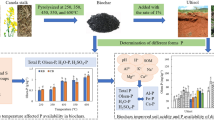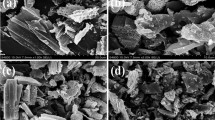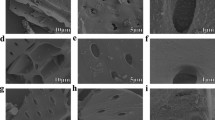Abstract
Purpose
The main proposes are to quantify different forms of alkalis in crop straw biochars and examine their contributions to improve the resistance of an acidic paddy soil to acidification.
Materials and methods
Biochars were prepared from the straws of maize and rape at 300 °C, and hydrochloric acid (HCl) was used to remove the inorganic alkalis from the biochars. The contents of functional groups on biochars were qualitatively and quantitatively characterized by Fourier transform infrared spectroscopy (FTIR) and Boehm titration. The contents of total inorganic alkalis, carbonates, other inorganic alkalis, and organic alkalis in the biochars were quantified based on acid–base titration. An acidic paddy soil from Anhui Province incorporated with biochars and HCl-treated biochars was flooded and then dried. The effects of the biochars on pH buffering capacity (pHBC) and pH changes of the paddy soil were examined.
Results and discussion
Some lactones were converted into carboxyl and hydroxyl groups when the biochars were treated by HCl, which caused the increase of carboxyl groups on the biochars. The contents of organic alkalis, carbonates and other inorganic alkalis in rape straw biochar were 129.92, 41.04, and 112.31 cmolc kg−1, which were significantly higher than those in maize straw biochar, and the corresponding contents in the biochar were 35.98, 0, and 56.69 cmolc kg−1. Compared to HCl-treated biochars, the addition of original biochars effectively increased the pHBC and enhanced the resistance of the acidic paddy soil to acidification. Inorganic alkalis and organic anions in the biochars could consume exogenous protons, thereby slowing down soil acidification, and inorganic alkalis made a greater contribution to inhibition of the biochars on soil acidification than organic anions. At the end of wet/dry incubation, the pH of the paddy soil incorporated with original biochars obviously increased, while that with HCl-treated biochars had no obvious change.
Conclusions
Both inorganic alkalis and organic anions in the biochars contributed to the increase in pHBC of the paddy soil. In comparison with the organic anions, inorganic alkalis in biochars played a dominant role in increasing the resistance of the paddy soil to acidification.










Similar content being viewed by others
References
Chen JP, Wu SN (2004) Acid/base-treated activated carbons: characterization of functional groups and metal adsorptive properties. Langmuir 20:2233–2242
Chen ZM, Xiao X, Chen BL, Zhu LZ (2015) Quantification of chemical states, dissociation constants and contents of oxygen-containing groups on the surface of biochars produced at different temperatures. Environ Sci Technol 49:309–317
Cheng S, Chen T, Xu WB, Huang J, Jiang SJ, Yan B (2020) Application research of biochar for the remediation of soil heavy metals contamination: a review. Molecules 25:3167
Dai ZM, Wang YN, Muhammad N, Yu XS, Xiao KC, Meng J, Liu XM, Xu JM, Brookes PC (2014) The effects and mechanisms of soil acidity changes, following incorporation of biochars in three soils differing in initial pH. Soil Sci Soc Am J 78:1606–1614
Enaime G, Bacaoui A, Yaacoubi A, Lubken M (2020) Biochar for wastewater treatment—conversion technologies and applications. Appl Sci-Basel 10:3492
Fidel RB, Laird DA, Thompson ML, Lawrinenko M (2017) Characterization and quantification of biochar alkalinity. Chemosphere 167:367–373
He MJ, Xiong XN, Wang L, Hou DY, Bolan NS, Ok YS, Rinklebe J, Tsang DCW (2021a) A critical review on performance indicators for evaluating soil biota and soil health of biochar-amended soils. J Hazard Mater 414:125378
He X, Hong ZN, Jiang J, Dong G, Liu H, Xu RK (2021b) Enhancement of Cd(II) adsorption by rice straw biochar through oxidant and acid modifications. Environ Sci Pollut Res 28:42787–42797
Hu YN, Cheng HF, Tao S (2016) The challenges and solutions for cadmium-contaminated rice in China: a critical review. Environ Int 92–93:515–532
Lammers K, Arbuckle-Keil G, Dighton J (2009) FTIR study of the changes in carbohydrate chemistry of three New Jersey pine barrens leaf litters during simulated control burning. Soil Biol Biochem 41:340–347
Pan JJ, Jiang J, Qian W, Xu RK (2015) Arsenate adsorption from aqueous solution onto Fe(III)-modified crop straw biochars. Environ Eng Sci 32:922–929
Pansu M, Gautheyrou J (2006) Handbook of soil analysis: mineralogical, organic and inorganic methods. Springer Science & Business Media
Shi RY, Hong ZN, Li JY, Jiang J, Baquy MA, Xu RK, Qian W (2017) Mechanisms for increasing the pH buffering capacity of an acidic Ultisol by crop residue-derived biochars. J Agric Food Chem 65:8111–8119
Shi RY, Hong ZN, Li JY, Jiang J, Kamran MA, Xu RK, Qian W (2018) Peanut straw biochar increases the resistance of two Ultisols derived from different parent materials to acidification: a mechanism study. J Environ Manage 210:171–179
Shi RY, Liu ZD, Li Y, Jiang TM, Xu MG, Li JY, Xu RK (2019a) Mechanisms for increasing soil resistance to acidification by long-term manure application. Soil Till Res 185:77–84
Shi RY, Ni N, Nkoh JK, Li JY, Xu RK, Qian W (2019b) Beneficial dual role of biochars in inhibiting soil acidification resulting from nitrification. Chemosphere 234:43–51
Sohi SP, Krull E, Lopez-Capel E, Bol R (2010) A review of biochar and its use and function in soil. Adv Agron 105:47–82
Tong XJ, Li JY, Yuan JH, Xu RK (2011) Adsorption of Cu(II) by biochars generated from three crop straws. Chem Eng J 172:828–834
Ulrich B (1986) Natural and anthropogenic components of soil acidification. Z Pflanzen Bodenk 149:702–717
Wan Q, Yuan JH, Xu RK, Li XH (2014) Pyrolysis temperature influences ameliorating effects of biochars on acidic soil. Environ Sci Pollut Res 21:2486–2495
Wang J, Wang PM, Gu Y, Kopittke PM, Zhao FJ, Wang P (2019) Iron-manganese (oxyhydro)oxides, rather than oxidation of sulfides, determine mobilization of Cd during soil drainage in paddy soil systems. Environ Sci Technol 53:2500–2508
Wang LW, Bolan NS, Tsang DCW, Hou DY (2020) Green immobilization of toxic metals using alkaline enhanced rice husk biochar: effects of pyrolysis temperature and KOH concentration. Sci Total Environ 720:137584
Xiao X, Chen BL, Zhu LZ (2014) Transformation, morphology, and dissolution of silicon and carbon in rice straw-derived biochars under different pyrolytic temperatures. Environ Sci Technol 48:3411–3419
Xu RK (2013) Amelioration principles and technologies for acidified red soils. Science Press, Beijing (In Chinese)
Xu RK, Zhao AZ, Yuan JH, Jiang J (2012) pH buffering capacity of acid soils from tropical and subtropical regions of China as influenced by incorporation of crop straw biochars. J Soils Sediments 12:494–502
Xu RK, Ji GL (2001) Effects of H2SO4 and HNO3 on soil acidification and aluminum speciation in variable and constant charge soils. Water Air Soil Pollut 129:33–43
Xue YW, Gao B, Yao Y, Inyang M, Zhang M, Zimmerman AR, Ro KS (2012) Hydrogen peroxide modification enhances the ability of biochar (hydrochar) produced from hydrothermal carbonization of peanut hull to remove aqueous heavy metals: Batch and column tests. Chem Eng J 200:673–680
Yadav DS, Jaiswal B, Gautam M, Agrawal M (2020) Soil acidification and its impact on plants. In: Singh P, Singh SK, Prasad SM (eds) Plant Responses to Soil Pollution. Springer, pp 1–26
Yi P, Wu GJ, Duan WY, Wu M, Pan B (2020) Research progress on modification and aging of biochar and its environmental implications. Mater Rev 34:03037–03043
Yuan JH, Xu RK (2011) The amelioration effects of low temperature biochar generated from nine crop residues on an acidic Ultisol. Soil Use Manag 27:110–115
Yuan JH, Xu RK, Qian W, Wang RH (2011a) Comparison of the ameliorating effects on an acidic ultisol between four crop straws and their biochars. J Soils Sediments 11:741–750
Yuan JH, Xu RK, Wang N, Li JY (2011b) Amendment of acid soils with crop residues and biochars. Pedosphere 21:302–308
Yuan JH, Xu RK, Zhang H (2011c) The forms of alkalis in the biochar produced from crop residues at different temperatures. Bioresour Technol 102:3488–3497
Zhao FJ, Ma YB, Zhu YG, Tang Z, McGrath SP (2015) Soil contamination in China: current status and mitigation strategies. Environ Sci Technol 49:750–759
Zhu HH, Chen C, Xu C, Zhu QH, Huang DY (2016) Effects of soil acidification and liming on the phytoavailability of cadmium in paddy soils of central subtropical China. Environ Pollut 219:99–106
Funding
This study was supported by the National Natural Science Foundation of China (grant numbers: 41877036 and U19A2046).
Author information
Authors and Affiliations
Corresponding author
Ethics declarations
Conflict of interest
The authors declare no competing interests.
Additional information
Responsible editor: Daniel CW Tsang
Publisher's Note
Springer Nature remains neutral with regard to jurisdictional claims in published maps and institutional affiliations.
Rights and permissions
About this article
Cite this article
He, X., Lu, Hl., Wu, Cm. et al. Effects of inorganic alkalis and organic anions in biochars on acidic paddy soil resistance to acidification. J Soils Sediments 22, 1201–1213 (2022). https://doi.org/10.1007/s11368-022-03152-9
Received:
Accepted:
Published:
Issue Date:
DOI: https://doi.org/10.1007/s11368-022-03152-9




